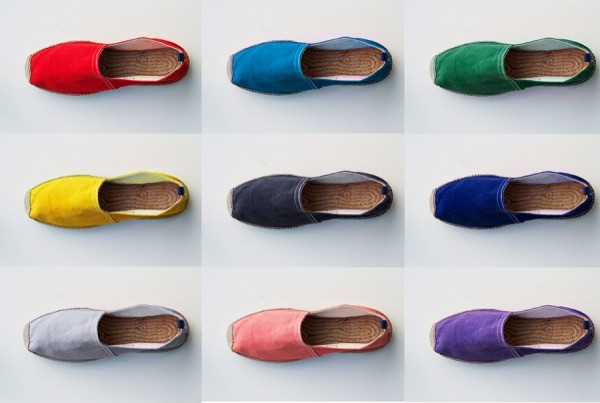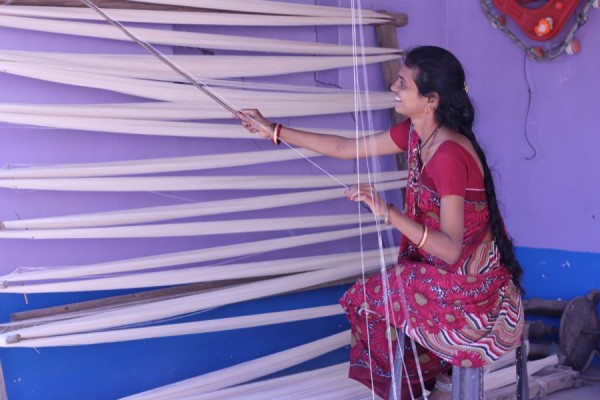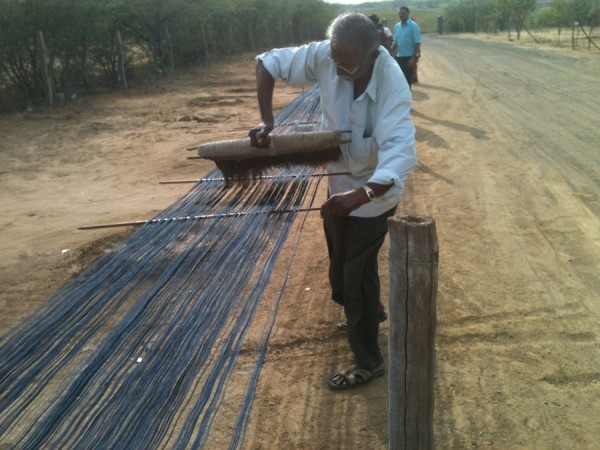Changing the world is hard. It’s easy to poke fun at blithely ignorant voluntourism in tropical climes, or reflect on 50 Cent’s failings as a humanitarian, but the truth is that genuinely helping others without being some neocolonial saviour, creating dependence, or otherwise abusing the relationship is hard. Which is not to say that what some idiots are doing is ok, but it does mean that when people are working hard to marry intelligent, reflective thinking with actually doing things, it’s worth taking notice.


Alice & Whittles, a startup focused on the ethical production of espadrille shoes, offers an interesting approach to using entrepreneurship as a way of fairly including underdeveloped communities in the creation of their products. The company’s approach is novel compared to many ‘social entrepreneurship’ schemes, which are often a thinly disguised attempt to make money off low-cost production by disadvantaged manufacturers. By working to create a production chain that’s both ethical and fair (in terms of sharing profit down the chain, for example), then making that chain transparent to customers, the company is trying to offer those buying its shoes a chance to really interrogate their model. And by focusing all the way down the chain to the very cotton that makes the fabric in their shoes, the company is going a lot further than most.
I got in touch with Alice & Whittles co-founder Sofi Khwaja to find out more about the challenges of turning ideas of doing good into a real-life company with ethics as its core.
RS: Can you walk through the process of deciding to launch Alice & Whittles? What is the company about?
SK: The decision to launch Alice & Whittles took some time. Certainly working within a refugee context helped shape our ideas. It exposed us firsthand to the after-effects of exploitation, corruption, and the unequal distribution of power and resources. Seeing the same things happen over and over again in different regions of the world really does make you call into question the status quo. It also makes you realize how much creativity and ingenuity people possess — even amidst the harshest conditions and with few resources and opportunity.
Combining these principles — giving people the opportunity to advance and to be treated fairly for their efforts, regardless of where in the world they are situated — we could make sustainable advances in poverty reduction. Business was the avenue we chose to use because of its global reach and huge potential to harness the power of the collective consumer.
It has become evident that consumers can collectively be a powerful force in making change. However, your article “The 7 worst international aid ideas” very much highlights that despite good intentions, poor implementation and short-term thinking may in fact work against the core goal.
Alice & Whittles is about finding an alternative to charity through the creation of great products that sustainably benefit everyone that has a hand in creating them. We are combining humanitarian principles within a strong economic model to create a powerful tool in combating poverty. We spent months researching different products and searching for the right partners. We wanted to develop a product that was simple, but which employed the local skill found in communities that are often on the economic/social fringes.
Currently we are partnered with Khamir, an NGO in rural Kutch, India, that oversees the production of our canvas. Small-scale organic farmers are partnered with rural hand weavers in the same region to create what we call ‘social fabric’ — the canvas for our espadrilles. Our canvas is made using organic, indigenous cotton produced by small-scale farmers in rural India. The use of this cotton dramatically reduces farmer risk and, in turn, farmer suicide (a significant problem in India). Organic cotton consumes 95% fewer chemicals and energy, supports biodiversity in the environment, and preserves the soil. Furthermore, with the ability to intercrop indigenous cotton, farms can help feed the surrounding community while growing the cotton.
We support sustainable development among weaving communities by teaming up with weaving cooperatives and purchasing canvas at fair-trade prices (three times the market rate), while providing health insurance, training, low-cost infrastructure, and no-interest advance payments through the local NGO. This method stimulates the local economy while providing the necessary support for long-term sustainable growth, self-determination, and self-sufficiency in the communities within which we are situated.
What was the process of thinking that led to the project, and how did you reach the point of having strong enough convictions to take a leap and pursue it?
I don’t really remember one particular day when we made the decision. It was more of a slow realization. We had the idea and the convictions and these had been cultivated over time and experience. The biggest challenge was getting over the social pressures that keep people in the same mold, doing the same things, according to what society dictates is acceptable. A lawyer, turned humanitarian now making shoes? On the surface it seems a bit crazy. I remember the response of an aunt when she heard of our plans: “You’ve studied law, gone to university for 8 years and now are going to be a shoemaker!” Though hard to digest sometimes, I would say that these negative remarks gave us even more drive to move forward with the idea.
For me, I think I had spent many years contemplating, arguing, and discussing the ideology behind sustainable solutions to poverty. To give aid or not to give aid? Can the current economic structure work to benefit the poor? But there comes a time where all that philosophizing stops being productive and you just have to try. It was really just the right time for us and we were ready to take on a new challenge.
We knew we would not have all the answers and we would make mistakes, but we were aware of this. We knew we just needed to get out there, stick to our principles, find the right people, bring them on board, and get the ball rolling. We also knew that there were so very many people out there who shared our ideals — it was just about finding them and bringing them together toward the end goal.
I suppose our thought was what was the worst thing that could happen? Getting out of a comfort zone, meeting people, traveling and learning things that you would not have otherwise learned is never a bad idea. So, off we went.
We decided the best place to start was in the apparel sector. Knowing that clothes are something that people buy on a regular basis, but also an area where most production takes place offshore in regions of the world where labour and environmental standards are poor and lacking in transparency. This seemed to be a logical starting point — small incremental differences in this sector can make big changes. The decision to venture to India in particular was made because India is a major producer of the raw materials for apparel (cotton and silk) and a big manufacturer of finished apparel for the export market.
Why espadrilles?
We really like espadrilles, both aesthetically and functionally — they’re a simple casual shoe that we’ve been taking with us on our travels for years. Most people in the world need shoes and consider them a basic necessity. We wanted to keep it simple and espadrilles are the simplest kind of shoe, using entirely natural inputs: cotton, jute, and rubber. We could effectively make espadrilles outside of a factory setting. Espadrilles are a traditional shoe that has historically been handmade by artisans, and we are continuing with this method of production.
In your Kickstarter video, you talk about creating an ethical supply chain all the way back to the source materials, and then making that chain transparent. Can you talk a bit more about this philosophy, and how it differs from historic approaches to — broadly speaking — using businesses to do good in underdeveloped places?
There is something incongruent about making large profits through exploitation, then giving a small amount back in the form of charity. Charity does not make up for exploitation and in many circumstances charity is not a long long-term solution to the core problem — it has the potential to merely mask the problem and/or create new ones.
As an extreme example, through a local NGO we met with people working in Mumbai’s massive garment sector located in Dharavi. Dharavi is one of the world’s largest slums and is home to over 2 million people in central Mumbai. The vast majority of the inhabitants of Dharavi are migrants from rural regions, who have left their homes and families in search of employment opportunities.
Of the garment workers we met, most were bonded labourers (modern-day slaves) working 17-hour days in confined spaces and sleeping in the same small area that they spent their days working. The “factories” were small loft spaces, with open sewers running beneath. When we asked one manager of a factory where their clothes are being sold, he proudly responded that 40% of the clothing made is for the export market. The clothing finds its way through three sets of middle men before being sent overseas and sold to consumers at prices hundreds of times their cost of production. (I did a photo essay on urban migrants — you can have a look at several pics online here.)
Would kicking back a portion of corporate profits to charity offset the damage done by these exploitative labour practices? The answer is simply no. Does providing handouts address the core of the problem of poverty? This is a bit more complex. Unfortunately, more often than not, the complex realities are oversimplified into shortsighted strategies that are easily digestible by the public…but not terribly effective in the long term.
What is effective for the long-term reduction of poverty? A support system for sustainable growth: Creating work opportunities, training, fair wages, access to loans, and advance payments. We are still working on this part, and we’ll continue to do so as we learn and collaborate with others in the field.
One of the most important factors in all of this is transparency. Transparency puts the power back into the hands of the consumer. Transparency allows the consumer to see and feel connected to the chain of people who are affected by their consumption choices. When processes are transparent, it makes it much more difficult to get away with exploitative practices.
How did sourcing a completely ethical chain work in practice? Where did the journey to find these ethical partners across the chain start and end up?
The journey was a long one and it continues. I suppose it started with quite a bit of research, then getting out there and meeting people across different regions, industries, sectors, and layers of society. We travelled around India, Delhi, Mumbai, Chennai, Kutch, Pune, Bangalore and met with policy makers, NGOs, businesspeople, and everyday labourers.
After a while, and a better understanding of the opportunities and challenges, we found ourselves tapped into a pretty active group of people who were working toward similar goals: sustainable uplift of marginalized communities through the creation of livelihoods.
We found a whole group of local NGOs who have been working at a grassroots level and have a good understanding of what it means to generate sustainable change within the regional/social context. These people are invaluable to our business model. Without them helping to answer the bigger questions the model just wouldn’t work. What are the pressing issues that need to be addressed on the ground? What is a better “quality of life”? What is a “fair wage”? All of these things are relative based on the context we are working in. Without local people working alongside us, we wouldn’t be able to be effective in our long-term strategy.
Now our India supply chain is managed by a local NGO whose mandate is to empower marginalized rural communities through weaving. Weaving is a skill traditional to the region, mostly engaged in by minorities and members of the Dalit communities. The majority of weaving communities have not benefited from the economic growth seen in India in recent years.
What lessons did you learn along the way?
- Great people are out there — sometimes we just have to take the time to seek them out.
- We are not all that different, regardless of where we originate.
- You can’t do it alone.
How did you decide to measure the ‘ethicalness’ of a given cotton producer, fabric manufacturer, etc?
This is a very good question. We started with our core principles and applied them to the sector within which we are working. Unfortunately it is not as simple as just looking for certifications. In many less developed regions of the world, certifications are far too costly to acquire and even costlier to maintain. We certainly needed to have a good understanding of what was behind the certifications — why organic cotton is important, why principles of fair trade should be adhered to. That took quite a bit of time and research on our part.
For us certifications are great, but more important is to find the right people to work with — ones who share our principles and values — build a relationship on trust, and work closely together to grow and develop better practices over time. This is where we have taken the time to understand how an organization that we partner with works, what their policies and practices are, and what they are working toward.
We aren’t perfect, and neither will our partners be. The key is to constantly ask question and collaboratively find and develop positive solutions.
For example, we are still working with our manufacturers in France to source the jute and rubber from organic suppliers. This is something we hope to have accomplished in the coming months as we grow and continue to develop business relationships.
What are your plans for Alice & Whittles in the future, and do you think there is a maximum scale beyond which it will be difficult to grow while still maintaining a rigorously principled supply chain?
First we will focus on solidifying our current supply chain — ensuring all the checks and balances are in place and that they are having a positive impact on the communities we are working within. We then hope to expand our product line and work in different regions of the world. Poverty is not a phenomenon restricted to the “global south,” and respect for workers is a principle that can be transferred to a supply chain in any part of the world.
I don’t think there is a maximum scale beyond which it will be difficult to grow. There are enough people in the world who espouse the same values and principles with whom we can develop solid relationships with. There are even more “barefoot entrepreneurs” around the world who have the skill and drive to make a better life for themselves and the people around them — if given the support and opportunity to thrive.


